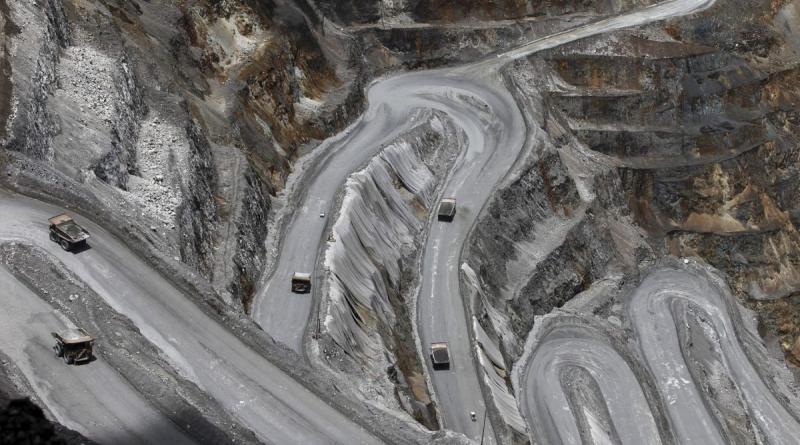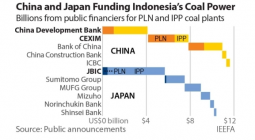Indonesia’s largest mining firm may drop coal for gas

Pushed by its American shareholders, banks and mounting climate change pressures, Indonesia’s largest mining company is actively studying a plan to switch from coal to natural gas to power its massive Grasberg underground copper and gold mine in Papua’s Central Highlands.
Freeport Indonesia (PTFI) has the option of either piping the gas from BP’s Tangguh liquified natural gas (LNG) plant, 490 kilometers to the northwest, or establishing a regasification plant to handle LNG shipments at its Timika port on the south coast.
“We’re still looking at which one is best,” PTFI president-director Tony Wenas told Asia Times this week. “But I’m sure we are not going to use coal anymore (in the future).”
PTFI now relies on a 195MW coal-fired station near Timika, linked by a 100km transmission line to the high-altitude mine where there is an additional 130MW of diesel capacity in place to tackle peak loads and emergencies.
While the company’s management has yet to make a definitive decision on the conversion, it is already installing 128MW of dual-fuel generating sets to meet the need for extra power to run a 20km-long electrified underground rail network, dewatering and ventilation systems and a third mill.
The new mill is needed to supplement current operations because the harder underground rock requires extra grinding, even though the daily ore output from the mine is down to 130,000 tonnes from a peak of 250,000 tonnes during open-pit days.
Experts say that provided BP has supply available – and that may come from a third production train which goes into operation early in 2022 – piping the gas from Tangguh would cost about US$500 million by most estimates.
Rather than crossing the 130km-long neck of land from the Bintuni Bay complex to the coastal town of Kaimana, it is understood Freeport is looking at a 900km undersea pipeline which will cover the entire distance to Timika.
LNG option, and obstacles
Apart from the $500 million cost of a regasification terminal, the LNG option offers equally-challenging obstacles: because the Arafura Sea is as shallow as 10 meters near the coast, only smaller tankers may be able to get close enough to an offshore discharge point.
Currently, bulk carriers are only partly loaded with copper concentrate at the port, then moved across a large sandbar to a buoy, 15-20 kilometers off the coast, where lighters are used to transfer the rest of the cargo.
On top of that difficulty is the additional expense involved in building a new combined cycle power station given the difficulties involved in converting the existing facility from coal to gas without major reconstruction.
The government, as the majority stakeholder, and US parent Freeport McMoRan Copper & Gold (FCX) are already committed to building a new $3 billion copper smelter at Gresik, East Java, and completing the expansion of the underground mine.
FCX claims to have lowered carbon emissions by more than 21% between 2015 and 2019 through what it says is a blend of energy-efficient technologies, equipment recycling and “clean energy deployments” at its nine other copper mines in North and South America.
PTFI, on the other hand, represents about 30% of the mining giant’s global GHG emissions and half of its Scope 1 emissions – those which are controlled or owned by the organization itself.
It is not alone in efforts to reduce emissions. Chinese nickel giant Tsingshan recently announced it was building a 2,000MW clean energy base in the next 3-5 years at its two major production facilities in Central Sulawesi and Maluku.
Unlike Freeport, Tsingshan intends to develop solar and wind plants and supporting facilities to supply electricity for the production of materials for the fast-growing electric-vehicle (EV) battery sector.
It did not touch on the power needed for producing stainless steel, which up until now has been provided by a 2,000MW coal-fired plant at its sprawling Morawali Industrial Park in Central Sulawesi, which opened in 2015.
The company has also been silent on reports that it may be planning to build a regasification terminal for its Weda Bay complex on the main Maluku island of Halmahera, which is now run by a 750MW coal-fired station.
The Mines and Energy Ministry last year turned down Tsingshan’s plan to add a fourth 250MW unit, forcing the company to look elsewhere for its energy needs as the facility expands into lithium battery production.

Another coal-fired power station
Interestingly, Australia’s Nickel Mines Ltd appears to be proceeding with the construction of another 380MW coal-fired station as part of a separate $1.8 billion smelter development on the same site.
Before it began the process of going underground in 2018, the Grasberg operation produced 2.52 million tonnes of Co2 equivalent a year, mostly from its power plants and large fleet of haulage trucks.
In last year’s updated Climate Change Report, using 2018 as a baseline, FCX targeted a 30% reduction in PTFI greenhouse gases (GHG) by 2030, but said the remote nature of the Grasberg operations made it a significant challenge.
The new power generators can run on a variety of fuels, which will allow them to switch to natural gas when it becomes available or to use renewables at some time in the future.
In the meantime, they will be powered by locally-produced B30 biodiesel under a government mandate aimed at reducing Indonesia’s emissions by at least 29% by 2030 and attaining carbon neutrality by 2060.
Freeport has still not abandoned an earlier plan to develop a 300MW flow-through hydroelectric plant on the Urumuka River, 100kms northeast of Timika, which tumbles out of Lake Enaratoli on the southern flank of the Central Highlands.
But Wenas says whether the firm decides to take up that option will depend on the government agreeing to extend its business license (IUPK) beyond 2041, noting that the plant will take seven years to build and leave only 13 years of operation.





